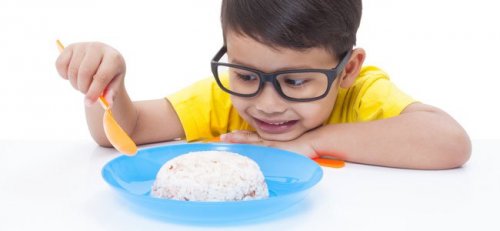Foods for Relieving Stomach Pain in Children


Written and verified by the nutritionist Saúl Sánchez Arias
Stomach pain in children occurs much more frequently than you might think. Without any apparent cause or even without any other symptoms, children often complain of this ailment.
While there may be multiple factors, there are a number of foods that can help relieve stomach pain.
Among the common causes is a mild inflammation of the walls of the stomach, known as gastritis. Other times, the child may not be able to tolerate certain proteins present in food (lactose, gluten, etc.), or he could be having a mild reaction to a virus.
It’s always recommended that you consult with your child‘s pediatrician to determine the origin of his stomach pain. However, in the meantime, you can help alleviate his discomfort with certain foods that create a soothing feeling in the stomach.
Below you’ll find a list of great allies for your child’s stomach. If he complains about any discomfort or stomach pain, it’s good to have these on hand. Take note and see the excellent results for yourself.
Foods to relieve stomach pain in children
In general, the common sense of every person and the maternal instinct of every mother leads us to a similar conclusion: rejecting certain types of foods that we believe can damage the stomach.
We leave aside products that include a lot of fat, sugar or spices. Dairy products, fruits and sweets are also cut out from the children’s menu without hesitation. We often simply turn to rice or to hard and dry cheeses, but are there other foods to relieve stomach pain in children?

Recommended foods: 3 helpful fruits to relieve discomfort
Who said that fruits shouldn’t be eaten with a tummy ache? Some of them can be very beneficial in these specific cases.
We invite you to discover what specialists in pediatric gastroenterology affirm about these helpful fruits:
- Papaya. It has the valuable ability to reduce stomach inflammation. That’s why it’s also highly advisable to use it in case of stomach ulcers. A highly recommended alternative is to prepare juices using papaya. You only need half a papaya, a glass of water and a teaspoon of honey for this delicious healing recipe. As an option, it’s possible to add another powerful anti-inflammatory: flax seeds.
- Pear. This is always a fruit recommended for people with “sensitive stomachs.” It’s noted for its anti-inflammatory effect on the intestinal flora. It’s also possible to consume it through natural juice. Simply add a glass of water to the liquified fruit.
- Banana. Provided they aren’t too mature – that is, preferably green – they have enzymes that are beneficial for combating inflammation in the gastric mucosa. You can also make juice by adding a cup of water. Many experts also recommend boiling the banana peel in water and then drinking the resulting liquid as a remedy for diarrhea.
2 foods suitable for lunch or dinner
White rice is one of these foods you surely already know about, because you’ve used it in these situations many times and it’s your recurring ally. This is one of the foods for relieving stomach pain and eliminating gas and acid from the stomach. That’s why it’s recommended for anyone having gastric problems.
This food can be accompanied by a handful of hard or dry cheese or a teaspoon of olive oil. Don’t add creams or tomato sauces, nor any fresh, creamy cheeses like mozzarella or cheddar.

The second food is chicken soup. This dish is very well received by children, and it’s also nutritious, light and very beneficial for gastritis. Another point in its favor is that it’s very easily digested.
If you want to prepare it, you just have to go through a series of simple steps. First, prepare a thin noodle soup with angel hair noodles, and then add boiled chicken. This dish is certainly an excellent source of protein and is very effective against episodes of childhood nausea.
Different ways to give liquids
Of course, it’s essential for your child to stay hydrated at all times. But to achieve this, you don’t always have to give water, which is often our first choice. There are numerous options that won’t only calm your child’s stomach, but also delight his taste buds:
- Chamomile infusion. Nothing has more benefits for your child’s stomach than chamomile. It’s an effective protector and repairer of the gastric membrane. It’s for this same reason that it’s always recommended for cases of indigestion, nausea and even vomiting.
- Coconut water. Its anti-inflammatory and antibacterial properties make it a recommended liquid for stomach pain in children. If this weren’t already enough, it also has a great hydrating power, surpassing that of any isotonic drink. Among its benefits are the purification and cleansing of the stomach, in addition to a huge energy boost.
Remember, there are numerous remedies and foods to relieve stomach pain in children. Try one that best suits your child, and don’t let him suffer unnecessarily.
All cited sources were thoroughly reviewed by our team to ensure their quality, reliability, currency, and validity. The bibliography of this article was considered reliable and of academic or scientific accuracy.
- Liu H., Hu M., Wang Q., Cheng L., Zhang Z., Role of papain like cysteine proteases in plant development. Front Plant Sci, 2018.
- Mayo Clinic. Gastroenteritis vírica. Enero 2022.
- Rabbani G. H, Teka T, et al. Clinical studies in persistent diarrhea: dietary management with green banana or pectin in Bangladeshi children. Gastroenterology. Septiembre 2001. 121 (3): 554-60.
- Sánchez B., Delgado S., Blanco Miguez A., Lourenço A., et al., Probiotics, gut microbiota and their influence on host health and disease. Mol Nutr Food Res, 2017.
- Savaiano D. A, Hutkins R. W. Yogurt, culture fermented milk and health: a systematic review. Nutrition Reviews. Mayo 2021. 79 (5): 599-614.
- Srivastava J, Shankar E, et al. Chamomile: a herbal medicine of the past with bright future. Molecular Medicine Report. Noviembre 2010. 3 (6): 895-901.
This text is provided for informational purposes only and does not replace consultation with a professional. If in doubt, consult your specialist.








